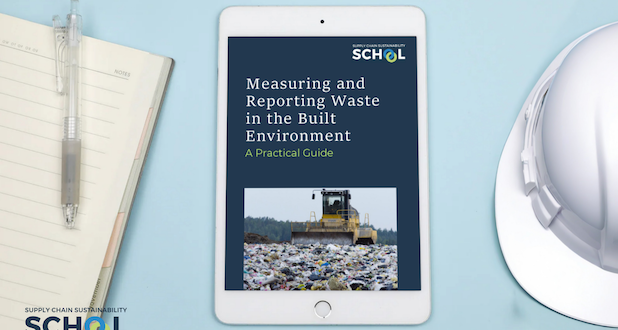The Supply Chain Sustainability School today launches a vital new guide, Measuring and Reporting Waste in the Built Environment: A Practical Guide, which reveals the scale of built environment waste and what the industry must do next.
The UK construction sector generates 62 per cent of the country’s total waste, with 32 per cent sent to landfill. While diversion rates are improving, they still fall short of the 99 per cent target. Waste from ongoing operations in existing buildings adds further complexity, increasing costs, carbon emissions, and environmental impact. Meanwhile, the UK’s circular economy remains underdeveloped, with only 7.5 per cent of materials reused nationally.
This new guide provides clear principles, scope, and methodology to enhance waste and resource efficiency reporting. It offers practical frameworks for construction projects and wider built environment activities, with entry, intermediate, and advanced reporting options. The guide also includes key metrics for tracking performance, supporting the growing focus on waste avoidance and circularity.
Matt Nichols, Divisional Director at Reconomy and Chair of the School’s Waste and Resource Use Leadership Group, said:
“We are delighted to launch this guide following months of collaboration across the industry. The zero avoidable waste agenda and circular economy are reshaping how we think about resources. Yet to make real progress, we urgently need to improve how waste is measured. After all, what gets measured has a chance to be managed.”
The guide aims to help organisations understand their current waste performance, set improvement targets, and engage stakeholders including clients and waste contractors with clear expectations on measurement and reporting.
Mark Turner, Associate Consultant and Lead for Waste and Resource Use at the Supply Chain Sustainability School, added:
“Our goal was to identify better metrics and KPIs for waste and resource efficiency across the sector. We built on the strong foundations of the ‘Construction Waste Measurement Protocol’ developed by the ENCORD Partnership, updating it for today’s challenges. This guide is a great example of effective waste reporting and promotion of circular economy principles in action – upgrading existing knowledge to support better industry outcomes.”
Industry professionals are encouraged to read the guide, discuss it within their organisations, and take positive steps toward improved waste and circularity reporting.
For more information and to access the guide, click here:





